When it comes to making an FM receiver it's always thought to be a complex design, however the one transistor simple FM receiver circuit explained here simply shows that it isn't the case after all. Here a single transistor acts as a receiver, demodulator, amplifier to constitute a wonderful tiny FM radio.
It's basically based on a superregenerative audion receiver circuit where the use of minimal components becomes the main feature of the unit.
However fewer components also means a few compromises involved, here the receiver requires a large metal base for grounding the unwanted signals, and for keeping the noise factor to the lowest, and also this system would work only in places where the reception is rather strong and thus may not be suitable in areas where the signal strength is thinner.
How the One Transistor FM Radio Receiver Works
As mentioned above, the circuit is basically a single transistor superregenerative RF oscillator with a constant amplitude.
Here we have tried to enhance the design such that the amplitude becomes considerably magnified in order to turn OFF the transistor completely during the oscillations.
This called for an increase in the feedback capacitor and also to use a transistor specifically designed for handling extreme high frequency ranges such as a BF494.
Further modifications include an inductor with the emitter of the transistor, and a capacitor across the emitter resistor of the transistor.
Due to this the transistor is switched ON as soon as the base emitter voltage of the transistor falls significantly, resulting in an abrupt cut off in the oscillations.
However this prompts the emitter capacitor to discharge, allowing the collector current to yet again resume its flow, initiating a fresh cycle of oscillation.
The above happening forces the circuit to flip flop between two situations, oscillator OFF and oscillator ON, resulting a sawtooth frequency of about 50kHz at the output.
Each time the circuit flips across the above ON/OFF states, results in a significant stepping up of the amplitude which in turn constitutes greater amplification of the received signals. The procedure also gives rise to noise but only as long as a station is not being detected.

The above design has one drawback, though. The output received from the above circuit would have greater content of sawtooth noise compared to the actual FM reception.
A smart technique can be seen employed in the following single transistor FM radio circuit to attribute better efficiency to this simple design.
Here we pull out the emitter capacitor C5 ground link and connect it with the output.
This results in a fall in the collector voltage as the collector current rises, which in turn forces the emitter voltage to rise, prompting the emitter capacitor to negate the situation at the output.
This enforcement results in making the sawtooth effect on the received signal practically to zero, thus presenting an FM audio with much reduced background noise.
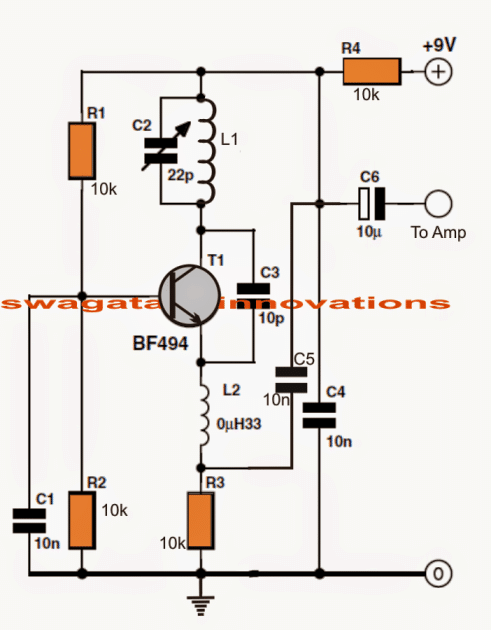
Single Transistor Radio with Audio Amplifier
To make the above circuit self-contained, an additional transistor stage may be introduced for enabling the radio to play the music loudly over a small loudspeaker.
The circuit is self explanatory, just the inclusion of a general purpose BC559 transistor along with a few inexpensive passive components can be witnessed in the design.

How to Make the Inductors
The involved coils or the inductors are very simply to wind.
L1 which is the oscillator coil is an air cored inductor, meaning no core is required, wire is super enamelled type, 0.8mm in thickness, diameter of 8mm, with five turns.
L2 is wound over R6 itself using 0.2mm super enameled copper wire with 20 turns.
How to Set Up the Circuit
- Initially when the circuit is switched ON, the output will be accompanied with substantial background noise which will gradually tend to disappear on detection of am FM station.
- This may be done by carefully tuning C2 with the help of an insulated screwdriver.
- Try to keep the tuning at the edge of the band of the particular FM station, with some practice and patience this would get easier with time.
- Once tuned, the circuit would respond to that reception every time its switched without the need for further alignment.
- As indicated at the beginning of the article, the circuit should be installed over a wide circular meta plate, preferably a solderable material, and all the ground of the circuit soldered on this plate.
- This is important to keep the circuit stable and avoid drifting away of the received stations and also for cancelling unwanted noise.
- The antenna in the proposed single transistor FM radio receiver circuit is not crucial and in fact should be kept as small as possible, a 10cm wire would be just enough.
Remember, the circuit also acts a like an effective transmitter circuit, therefore keeping the antenna size bigger would mean transmitting noise across the ether and disturbing your neighbors radio reception.
The upside being that the design can also used as a walkie talkie within a small radial distance....more on this next time.
Smallest One Transistor FM Radio Receiver Circuit
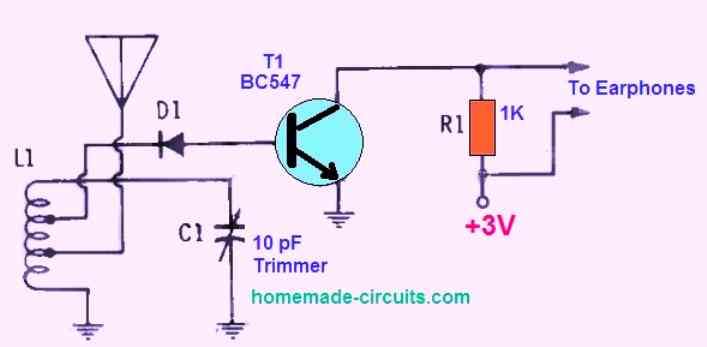
Parts List
- C1 = 10 pf variable trimmer capacitor.
- D1 = 1N82 diode.
- L1 = 5 turns using No. 16 magnet wire wound on a 3/4 -inch diameter coil former, 1/2 inch long. It should be tapped at 1/2 turn from the ground side for connecting the antenna, and tapped 2 turns from top of coil for connecting the diode.
- T1 = BC547 transistor.
- R1 = 1K 1/4 watt 5% resistor.
- Earphone (magnetic)
This is a fascinating small single transistor FM receiver that, unbelievably, can tune the full 88-108 MHz FM music band while still producing enough energy to power a typical set of magnetic earbuds.
The tiny receiver is so small that it could be integrated into an empty cigarette pack. This tiny FM receiver can additionally catch the audio paths of some television channels.
How to Setup
The only challenging aspect is really the L/C circuit, that comprises of a 10-pf trimmer capacitor and a tapped antenna coil connected in parallel.
After completing L1 winding, test the circuit first. Try flipping the taps on the coil if you are having trouble hearing the FM stations.
If you're still having trouble, try experimenting a little with the coil by adjusting the taps a fraction of a turn at a time, individually, while attentively listening via the headphones and tweaking C1 with each adjustment you make.
Antenna Specifications
Just about any length of strong (whip-like) No. 10 or No. 12 wire could be used for the antenna. However we discovered that 3 and 1/8 inches worked best for the middle of the f-m band.
If the indicated 1N82 diode cannot be found, any other vhf diode could be used instead.
Other diodes like the OA91 work well at this frequency as well.
If magnetic earbuds are used, which we advise, simply remove R1 from the circuit.
Single IC Small FM Radio Circuit
If you are looking for an FM radio circuit which should be as small as possible yet have a very high accuracy in terms of band selection, then you can try the following concept.
It uses a single chip TDA7000 for the modulation and demodulation of the FM stations, and uses the IC LM386 for amplifying the captured audio signals.
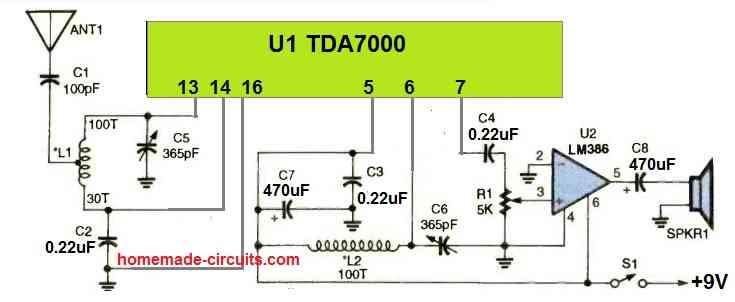
Everything in this single chip FM radio circuit looks straightforward except the two inductors. The two inductors L1 and L2 can be built in the following manner.
Both the coils have 100 turns and uses 28 SWG super enameled copper wire. Coil L1 has a center tap exactly at the midway of the 100 turns, that is at the 50th turn.
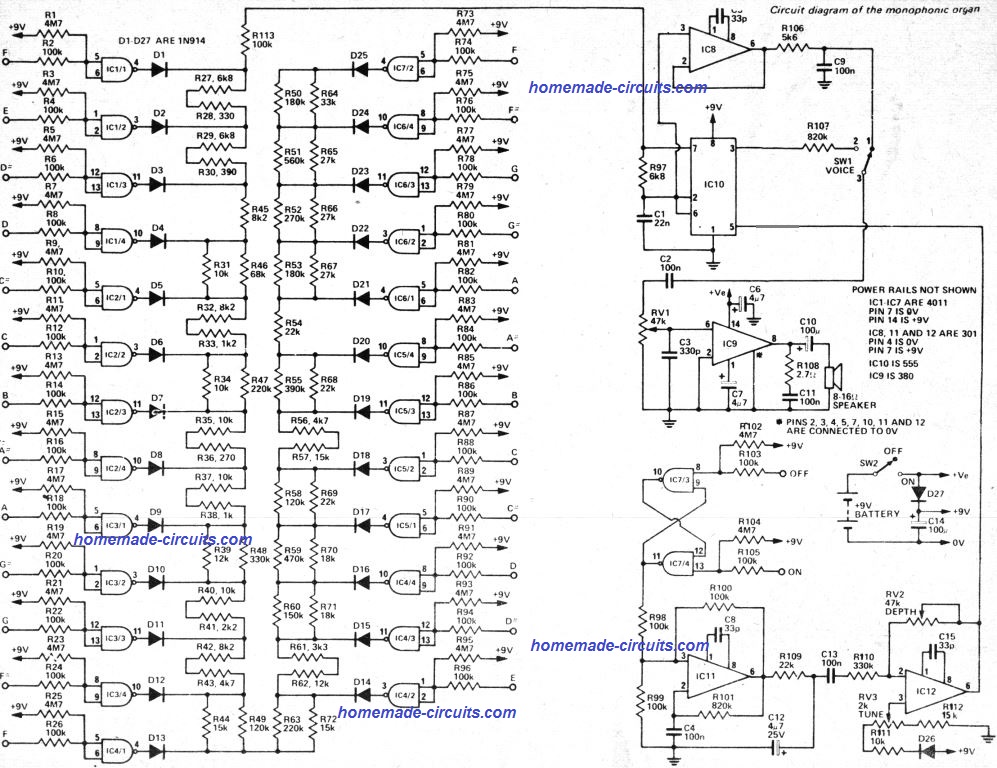
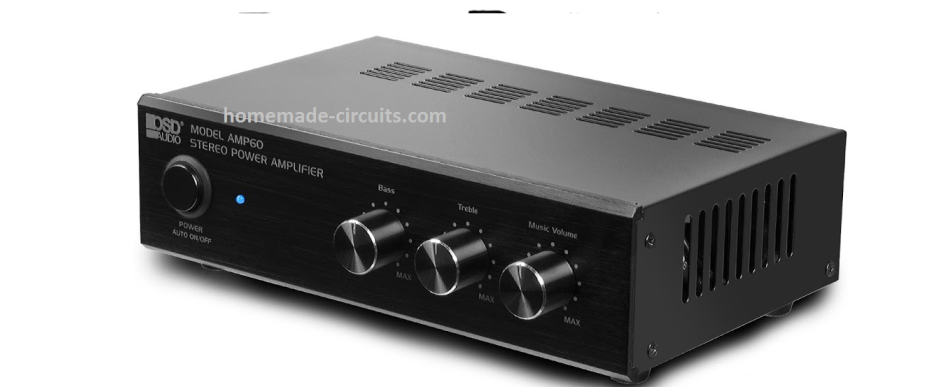

Comments
It is nice explanation.
I am school science maths teacher later I become a telecom tech and worked in srilanka and
Dubai.
Lot of circuits they dont mention diameter of the coil wounding pipe.
even it is air cored one we have to use a pipe.
example a pensil etc or hand made one.
Also in this circuits if stage not there.
I hope it is required for AM circuits only.
Anyway I like transistir FM circuits.
So if you can publish powerful transistor circuits it is useful to the whole world.
Also can we use this knowledge for home buisness purpose
I am 73 years man.
Now no job no pension no children no wife no job.
Living alone but I am active man not idle person
I study chemistry, physics, maths and electronics.
So time passing no problem.
I am interested to make old fashion radios even it is big very nice
how to find casing for that can you guide me.
my e mail is ptrickperera@gmail.com
Thank you Patrick, for your interest in AM FM radio circuits.
I myself normally use a 3mm or 4mm drill bit to wind the coils.
10.7 MHz IF stage is utilized in FM radios also, so yes IF stage is required in FM radios also.
Yes, you can use any of the circuits from this blog for commercial purpose or for home business.
Here’s a link which has a handful of old fashioned radio circuits which you can try:
https://www.homemade-circuits.com/tuned-radio-frequency-receiver-trf-circuits/
For the casing you can try searching on amazon, eBay etc…
Let me know if you have any further doubts or questions, I will try to help!
You have given a very good article for the budding experimenter. Congratulations. However, there is one circuit that I think must be in error component wise. That is the Single IC Small FM Radio Circuit with the TDA7000. You show the coils as 100 turns and the variable capacitor as 365 pF. These would be typical values for an AM radio, but I can not imagine them working in the FM range.
Thanks so much for your kind words! Glad you liked it.
You are absolutely correct! An FM radio coil cannot have a coil of 100 turns, and a 365pF tuning capacitor… it seems to be a modified AM radio circuit, not an FM radio.
Here’s the actual TDA7000 based circuit taken from the datasheet of the IC. Make L1 = 56nH (2 or 3 turns, 5mm dia)
Connect 33pF or 47pF across it (CP). Put a 10pF cap in parallel (CW). Then add a trimmer capacitor (10 to 30pF range) to fine tune.
https://www.homemade-circuits.com/wp-content/uploads/2025/04/IC-TDA7000-FM-radio-circuit.jpg
Hi Swag
Thanks for such a lot of really useful information. Just a question on the ‘Smallest One Transistor FM Radio Receiver Circuit’ – is the coil close-wound or loose-wound (L1 = 5 turns using No. 16 magnet wire wound on a 3/4 -inch diameter coil former, 1/2 inch long)? Although, I suppose when you say 1/2 inch long, that means it’s fairly close-wound.
Many thanks, Peter
Thanks Peter,
Yes, it is close wound, and the wire thickness does not need to be thicker than 1 mm, according to me.
bonjour,
radio FM base TDA7000
L1 – L2 , 100 tours sur quel diamètre ??
Remerciements
Hi,
the diameter of the coil is not specified in the schematic. But based on common FM radio designs, a practical coil diameter for 100 turns using 28 SWG wire is typically around 4 mm to 6 mm.
Merci pour l’info
très cordialement
I’m looking for a way to adjust the phase of one antenna to match the phase of a second antenna for max signal.
Variable indicators and capacitors.
Sorry, I don’t think I have this circuit design with me at the moment…
salve sign swagatam sono un tecnico elettronico italiano siccome dovrei realizzare un semplice ricevitore radio in FM con 2 transistor e nel web ne ho trovati ma con risultati deludenti vorrei che pubblicasse un o schema o diversi schemi elettrici allo scopo grazie giuseppe
Salve Giuseppe, te la mando io la schema con il ricevitore FM con un transistore BF199 come ricevitore e poi amplificatore audio a 3 transistori (BC547) gli ultimi due con la conessione galvanica…Tutto a baso voltaggio da 1.2volt fino a 1.5v .
Mi troverete tutii dal Italia qui : yo.el.yo@protonmail.com
You can publish my email address. You have my consent. Thank you.
Hi giuseppe,
A two transistor FM radio will only work for radio strong FM radio stations which are nearby, it will not not be able to catch distant FM stations.
The third circuit from top is a tested design, you can try it.
Actually I want to know some details remote control coordination pls
Good day sir. There was an FM transmitter designed by you using bc547 and um66 and other passive components as remote control transmitter, while already-made radio was the receiver to trigger cd4017 to trigger relay to off/on a load. I want to ask, can this FM receiver using bf494 and bc559 get the signal from the transmitter
of um66 and bc547 designed by you? Thanks
Hello Emmanuel, I guess you are referring to the following post:
https://www.homemade-circuits.com/how-to-make-fm-remote-control-using-fm/
You will get a much higher range if you use an actual FM radio for the above design, the range can be more than 30 meters. However using the single transistor version as the radio receiver, the range can be hardly 10 meters.
Sir, I don’t understand. Does it mean that the one transistor bf494, bc559 fm receiver can’t get the signal from bc547, um66- based FM transmitter(fm remote Tx) up to 30 meters?
Yes that’s correct! A proper FM radio has so many parts and sophisticated circuitry which makes it highly sensitive, that’s why its range will be more, whereas the single transistor FM radio is a crude form of FM radio so naturally its sensitivity and range will be much less than a full fledged radio.
Sir i don`t have BF494 transistor. So can i use others like 2N3904, BC547 2N2222 ……?
I think BC547 should work, you can try it.
Hi Swagatam,you mentioned that you are a manufacturer,what do you manufacture?
Hi Daniel, I used to manufacture automobile electronic products a few years ago but now I have discontinued it.
Sir….we r working on this project…….sir….why did u used 2 transistors….sir..? Is they r mandatory….but the concept itself is a fm radio with a single transistor…?…na sir…
Hello Sruthi, only the last diagram has two transistors rest all are single transistor. The extra transistor in the last diagram is for amplification so that a loudspeaker can be added in the design
God bless you sir .keep up the good work
Thank you for the quick response sir.pls since this circuit cannot transmit subwoofer signal ,can you please suggest me a better circuit to use instead?
You are welcome Muhammad, you can try the following transmitter circuit instead:
Make this Wireless Speaker Circuit
However, for the receiver you will have to use a small FM radio.
Hi sir, God bless you with this wonderful job u doing . Pls I want to know if I can use this circuit to make a wireless subwoofer?that is the receiver will be enlocsed in the sub woofer box.
And can bc547 be used instead of bf494?
Thank you Muhammad, I don’t think this circuit can be used for transmitting sub woofer signals, since the quality of the transmission may not be of H-Fi quality.
Hi !
Where can we get 400 ohm speaker my friend ? I’ve never seen such value of Speaker so far. Or ,instead, can we connect it any amplificator? Thanks in advance.
You can try a 100 ohm speaker, or simply connect an LM386 type amplifier with an 8 ohm speaker, or you can also try any of these transistorized small amplifier
Hi Swagatam,
Very interesting circuit. I have a question though. Instead of immediately soldering everything together, I’ve first tried to build the circuit on a breadboard. Understanding that this is not optimal, I expected that this would just give me a bunch of static. Instead, I get no sound whatsoever, except for a slight crackle when I connect/disconnect the battery. I double-checked all the components and used a multimeter to verify all connections are OK. Voltages across components are what I’d expect.
Can you think of a reason why the circuit would behave this way on a breadboard?
Hi Thom, any high frequency RF circuit should be strictly built by soldering and by assembling the parts close to each other. So a breadboard is big no for such designs.
Moreover, for stability the board must be attached with a large grounded plate, as shown in the first image.
If a professionally built PCB is used then the PCB must be ground plain type, meaning all the part connections must be surrounded with copper tracks
Hi Swagatam, that is very informative. As a relative beginner when it comes to electronics, I never realized that a breadboard would not suffice for testing high frequency electronics. Thank you for taking the time to explain this.
No problem Thom, please keep up the good work!
This transistors must work:
C945p: 450 mhz Ft
Bc237b: 250 mhz Ft
Bf199: 500 mhz Ft (works better than bf494)
2n3904: 300 mhz Ft
S9018: 1.1 ghz Ft (works better than bf494 and bf199)
S9014: 270 mhz Ft
Bc547b: 300 mhz Ft
Thanks
With coil
OK, then it’s fine
And can I use fixed capacitor instead of trimmer capacitor ?
Then how will you adjust and tune the transmission frequency?
Hi. Can I use bc556 and 2n3904?
you can use them.
Can I use bc 557 for amp
yes you can….
I built this circuit. but the output is very noisy. I hear only loud buzz sound
Did you use a base plate for the grounding as indicated in the first image?
Fidhul, you can do that but this circuit is very basic and might not be able to catch long distance weak receptions…
sir can i tune the radio to 137Mhz to pull image from noaa satellite